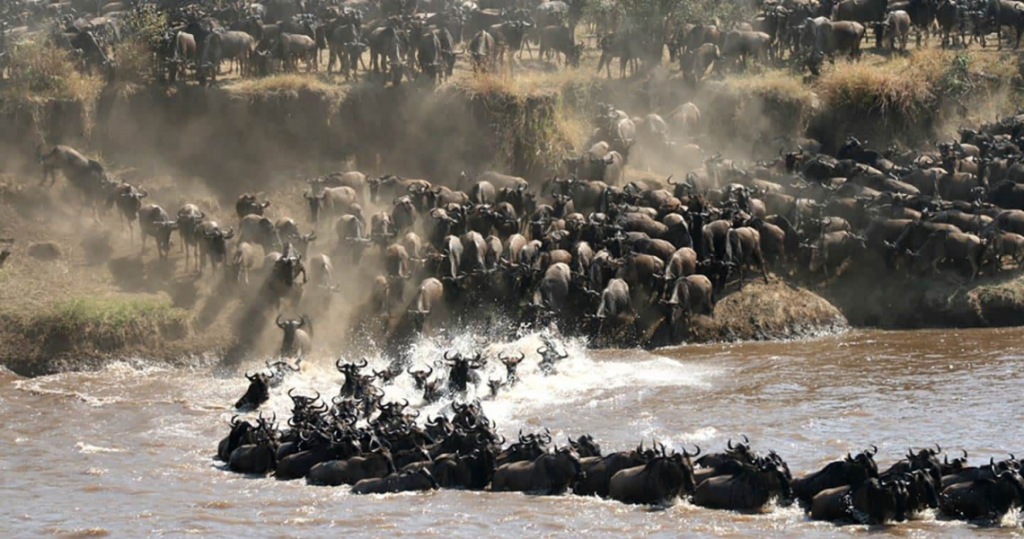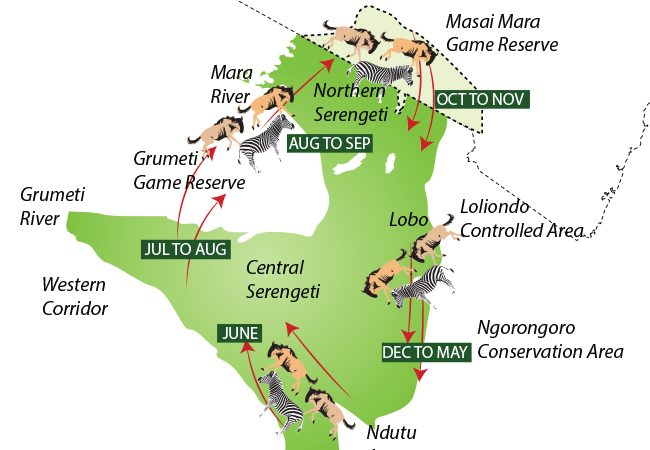Why Wildebeest Migration in Kenya and Tanzania 2025/2026: The Wildebeest Migration is one of the most spectacular natural events on Earth, attracting wildlife enthusiasts, photographers, and travelers worldwide.
Table of Contents
Introduction
The migration, which spans Kenya and Tanzania, is an awe-inspiring journey where millions of wildebeest and other herbivores move through the Serengeti National Park in Tanzania and the Masai Mara National Reserve in Kenya. In 2025/2026, the migration promises to be even more remarkable, offering travelers the chance to witness this mesmerizing wildlife spectacle firsthand.
Why Travel to Kenya and Tanzania for the Wildebeest Migration in 2025/2026?
In 2025/2026, a trip to see the Wildebeest Migration is more than just a wildlife tour—it’s a cultural experience as well. Traveling through Kenya’s Masai Mara and Tanzania’s Serengeti provides an opportunity to interact with the indigenous Maasai tribes, who have lived in harmony with these lands for centuries. You can learn about their traditional customs, enjoy their vibrant dances, and gain insight into the relationship between the Maasai people and the migrating animals.
Additionally, both countries offer a variety of eco-friendly and luxury safari lodges that enhance your experience, allowing you to enjoy a high-end stay while supporting sustainable tourism initiatives in Africa.

What is the Wildebeest Migration?
The Wildebeest Migration is a yearly event where approximately 1.5 million wildebeests, along with hundreds of thousands of zebras and gazelles, move from the southern Serengeti plains to the lush grasslands of the Masai Mara. This movement is driven by the search for food and water, and it forms one of the largest and most famous wildlife migrations in the world. The migration is not just about the animals moving—it’s about life, survival, and the circle of life as predators like lions, cheetahs, and crocodiles follow closely behind.
Best Time to Witness the Migration
The Wildebeest Migration is a continuous journey, but certain months offer the best opportunities for viewing. In 2025, July to October will be prime months for observing the dramatic river crossings in the Masai Mara and Serengeti. During these months, the wildebeest must cross crocodile-infested rivers, and the dramatic scenes are a photographer’s dream.
1. Calving Season (January to March) – Southern Serengeti
The migration begins with the calving season in the southern plains of the Serengeti in Tanzania, particularly around Ndutu and the Ngorongoro Conservation Area. During this period, hundreds of thousands of wildebeest calves are born, making it an incredible time to witness newborns taking their first steps. The presence of vulnerable young attracts numerous predators, creating dramatic scenes of survival.
Pro Tip: Calving season is perfect for travelers who love the raw intensity of predator-prey dynamics.
2. The Journey North (April to June) – Central and Western Serengeti National Park.
As the southern plains dry up, the herds move northward towards the Seronera area and the western corridor of the Serengeti. This phase of the migration sees long columns of wildebeests stretching across the horizon. The famous Grumeti River crossing occurs during this period, where crocodiles lie in wait for any wildebeest daring to make the dangerous swim.
3. River Crossings (July to October) – Northern Serengeti and Maasai Mara plains.
The dramatic Mara River crossings are the pinnacle of the Great Migration. This period is marked by thousands of wildebeests and zebras braving the treacherous waters of the Mara River, attempting to reach the lush grasses of the Maasai Mara in Kenya. The crossings are a game of life and death, with predators such as crocodiles and lions taking advantage of the chaos. This is the best time to witness the migration in the Maasai Mara and the northern Serengeti.
Pro Tip: Book your accommodation close to the Mara River for front-row seats to this heart-pounding spectacle.
4. Return Journey (November to December) – Serengeti Plains
By late October or November, the short rains return to the Serengeti, and the herds start their southward journey back to the Serengeti plains. The grasslands of the southern Serengeti once again become their final destination as the migration cycle begins anew.
Wildlife Viewing Beyond the Migration
While the Wildebeest Migration itself is the main draw, both Kenya and Tanzania offer incredible wildlife safaris year-round. In Tanzania, the Serengeti National Park offers game drives where you can spot the “Big Five” (lions, elephants, leopards, rhinos, and buffalo), as well as cheetahs, hyenas, and hippos. Similarly, the Masai Mara in Kenya provides rich wildlife experiences, with opportunities to spot not only wildebeests but also giraffes, zebras, antelopes, and wild dogs.
Where to Stay During the Migration
Choosing the right accommodation is key to maximizing your experience. Here are some top recommendations depending on where the migration is happening:
1. Southern Serengeti (Calving Season)
- Ndutu Safari Lodge: A fantastic location for witnessing the calving season.
- Luxury Tented Camps: Several mobile camps follow the migration and set up in prime viewing areas.
2. Central and Western Serengeti
- Seronera Wildlife Lodge: Perfect for watching large herds moving through the central Serengeti.
- Grumeti River Lodge: Offers excellent views of the river crossings during the western corridor migration.

3. Northern Serengeti & Maasai Mara (River Crossings)
- Sayari Camp: A luxurious camp located in the northern Serengeti, close to the Mara River.
- Governors’ Camp: Set in the heart of the Maasai Mara, offering a front-row seat to the dramatic river crossings.
Essential Tips for Planning Your Migration Safari
- Book Early for the Best Spots: The migration draws visitors from all over the world. Secure your booking 6-12 months in advance, especially if you plan to visit during the peak of the river crossings.
- Consider Mobile Camps: Mobile safari camps are an excellent choice as they follow the herds, allowing you to stay close to the action no matter where the migration moves.
- Time Your Visit Right: If you’re keen on seeing a specific part of the migration—whether it’s calving or river crossings—plan your travel dates carefully. It’s nature, so some unpredictability is part of the experience.
- Pack Wisely: Bring layered clothing for cooler mornings and evenings, along with essential items like binoculars, sun protection, and a camera with a good zoom lens for wildlife photography.
- Travel with Expert Guides: An experienced guide will ensure you get the most out of your safari, knowing the migration routes and helping you get the best viewing spots.
Why is the Wildebeest Migration So Special?
The Wildebeest Migration is a once-in-a-lifetime experience that offers more than just wildlife viewing—it’s a powerful reminder of the raw beauty and unpredictability of nature. Witnessing the migration crossing, with tens of thousands of wildebeests making their way across rivers while being pursued by predators, is both exhilarating and emotional. The scale of this migration, combined with the stunning landscapes of the Serengeti and Masai Mara, creates an unforgettable experience for travelers.
What to Expect During Your Wildebeest Migration Safari
When booking a Wildebeest Migration safari in 2025, you can expect:
- Game drives in the Serengeti and Masai Mara for close-up wildlife encounters
- River crossings where wildebeests face crocodiles
- Opportunities to see predator-prey interactions, including lions chasing wildebeests
- Cultural experiences with the Maasai people
- Luxury lodges and sustainable eco-tented camps near the migration routes
A well-planned safari can offer a mix of action-packed wildlife moments and quiet time for relaxation, ensuring that your Wildebeest Migration adventure is one to remember.
Conclusion: Plan Your Wildebeest Migration Safari Today
The Wildebeest Migration in 2025/2026 is an event not to be missed. With millions of wildebeests on the move, the dramatic river crossings, and the thrill of predator-prey interactions, this migration offers one of the world’s most unforgettable wildlife experiences. Whether you’re an avid photographer, a wildlife lover, or someone seeking a new adventure, witnessing the migration in Kenya and Tanzania will be a once-in-a-lifetime event that will stay with you forever.
Ready to witness nature’s greatest show? Don’t miss out on this once-in-a-lifetime adventure. Whether you’re looking to experience the thrilling river crossings or the serenity of the calving season, now is the perfect time to plan your wildebeest migration safari. Reach out to our expert team today to tailor a custom safari experience that puts you at the heart of the action.
FAQ’S
When should I book for the 2025/2026 wildebeest migration?
Aim for at least 9–12 months in advance if you want private camps or charter flights; group‑camp spots can fill within 6 months.
Are mobile migration camps safe for families?
Yes, many camps offer family tents and child‑friendly guides

Your articles are extremely helpful to me. May I ask for more information?
Thanks for your help and for writing this post. It’s been great.
Good web site! I truly love how it is easy on my eyes and the data are well written. I am wondering how I could be notified whenever a new post has been made. I’ve subscribed to your RSS which must do the trick! Have a nice day!
Your articles are extremely helpful to me. Please provide more information!